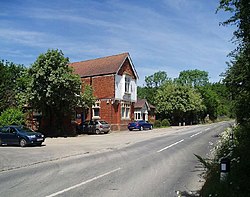Ardingly railway station
| Ardingly | |
|---|---|
 |
|
| Location | |
| Place | Ardingly |
| Area | Mid Sussex, West Sussex |
| Grid reference | TQ338276 |
| Operations | |
| Pre-grouping | London, Brighton and South Coast Railway |
| Post-grouping |
Southern Railway Southern Region of British Railways Aggregates depot |
| Platforms | 2 |
| History | |
| 3 September 1883 | Opened |
| 7 July 1935 | Ardingly branch electrified |
| 2 April 1962 | Closed to freight |
| 28 October 1963 | Closed to passengers |
| 1963 | Aggregates depot opened in goods yard |
| Disused railway stations in the United Kingdom | |
| Closed railway stations in Britain A B C D–F G H–J K–L M–O P–R S T–V W–Z |
|
|
|
|
Ardingly was a railway station which served the West Sussex village of Ardingly in England. It was opened on 3 September 1883 by the London, Brighton and South Coast Railway (LBSCR) closed eighty years later and is currently used as an aggregates depot. The Bluebell Railway owns the trackbed from just east of the station to Horsted Keynes and has long term plans to rebuild the line.
The LBSCR opened a 4½-mile link line between Horsted Keynes on its Lewes to East Grinstead Line and Haywards Heath on the Brighton Main Line. Doubled throughout, the line curved away from Horsted Keynes over Sheriff Mill Viaduct (117 yards and named after the nearby Lower Sheriff Farm), climbing on a gradient to reach Lywood Tunnel (218 yards) before continuing on the level for nearly 2 miles to reach the line's only intermediate station at Ardingly. From Ardingly, the line continued for a further mile to reach Copyhold Junction on the Brighton Line, just south of the Ouse Valley Viaduct. At first there was no signal box at the junction, with services running on an independent line parallel to the Brighton Main Line as far as the north-facing bay platform at Haywards Heath. A box was installed in 1912 which remained in use until 1932 when Haywards Heath was rebuilt with up and down loop platforms, and a new box brought into service there.
The line opened without ceremony, with the first service, a goods train, leaving Haywards Heath at 8.34am to collect freight at Ardingly and continue to Horsted Keynes. It was later to prove its worth as a useful alternative to the Brighton Main Line in both wars and for specials to Lingfield Racecourse.
Designed by Thomas Harrison Myres, the main station building was sited at road level away from the platforms. In common with other Lewes and East Grinstead line stations, it was constructed in a neo-Queen Anne style and presented as a two-storey Victorian country cottage. The upper storey is decoratively timbered with plaster patterning (flower patterns in black on a white background) and projecting slightly; unlike the other stations on the line, Ardingly was never tile-hung.
...
Wikipedia
